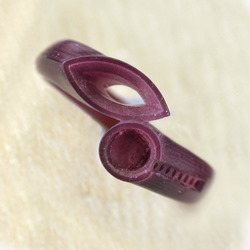Revising Milled CAD/CAM Models
I have great respect for the capabilities of CAD/CAM technology, and Ive seen some absolutely amazing pieces generated by it. Ive also seen some pieces that miss the mark; they need some simple revisions to make them easier to produce and aesthetically pleasing. I asked Marc Williams of MarcCo Jewelers in Luzerne, Pennsylvania, for an assortment of CAD castoffs -- pieces with "issues" that I could use to demonstrate how to resolve production and design problems. Ill evaluate and revise the first of these pieces here, and others will follow in subsequent issues..
5 Minute Read
The process involves examining, evaluating, revising, and repeating until the piece is done. If you have time, you can make these adjustments on the computer and mill a new model. But sometimes it's quicker to make the changes by hand — and it's really helpful to know how. Finessing the models by hand helps you to see, feel, and understand form and construction — leading to a greater understanding of the design process.
Author's Note: I have great respect for the capabilities of CAD/CAM technology, and I've seen some absolutely amazing pieces generated by it. I've also seen some pieces that miss the mark; they need some simple revisions to make them easier to produce and aesthetically pleasing. I asked Marc Williams of MarcCo Jewelers in Luzerne, Pennsylvania, for an assortment of CAD castoffs — pieces with "issues" that I could use to demonstrate how to resolve production and design problems. I'll evaluate and revise the first of these pieces here, and others will follow in subsequent issues.
While examining the piece, ask the two magic questions: Where is my eye being pulled? and Why? Ask these two questions continuously when designing on the computer or on paper, and keep asking the same questions while you are working on the milled, grown, hand-carved, or fabricated pieces. When something is out of whack, disproportionate, or incongruous, it creates a visual tension that is compelling. Adjust, repair, and rework the area that causes the visual tension, then keep looking around the piece, asking the questions repeatedly, and modifying. When all the visual tensions are resolved, you (and your customer) will look at the piece and be pleased.
To continue honing your model-making skills, flip through trade magazines, look at the jewelry, and ask the questions: Where is my eye being pulled? and Why? And be sure to keep these two important questions in mind when designing or working at the bench. Asking and answering them will improve your work and make your processes more enjoyable.
The award-winning Journal is published monthly by MJSA, the trade association for professional jewelry makers, designers, and related suppliers. It offers design ideas, fabrication and production techniques, bench tips, business and marketing insights, and trend and technology updates—the information crucial for business success. “More than other publications, MJSA Journal is oriented toward people like me: those trying to earn a living by designing and making jewelry,” says Jim Binnion of James Binnion Metal Arts.
Click here to read our latest articles
Click here to get a FREE four-month trial subscription.
You assume all responsibility and risk for the use of the safety resources available on or through this web page. The International Gem Society LLC does not assume any liability for the materials, information and opinions provided on, or available through, this web page. No advice or information provided by this website shall create any warranty. Reliance on such advice, information or the content of this web page is solely at your own risk, including without limitation any safety guidelines, resources or precautions, or any other information related to safety that may be available on or through this web page. The International Gem Society LLC disclaims any liability for injury, death or damages resulting from the use thereof.
The All-In-One Jewelry Making Solution At Your Fingertips
When you join the Ganoksin community, you get the tools you need to take your work to the next level.
Trusted Jewelry Making Information & Techniques
Sign up to receive the latest articles, techniques, and inspirations with our free newsletter.
